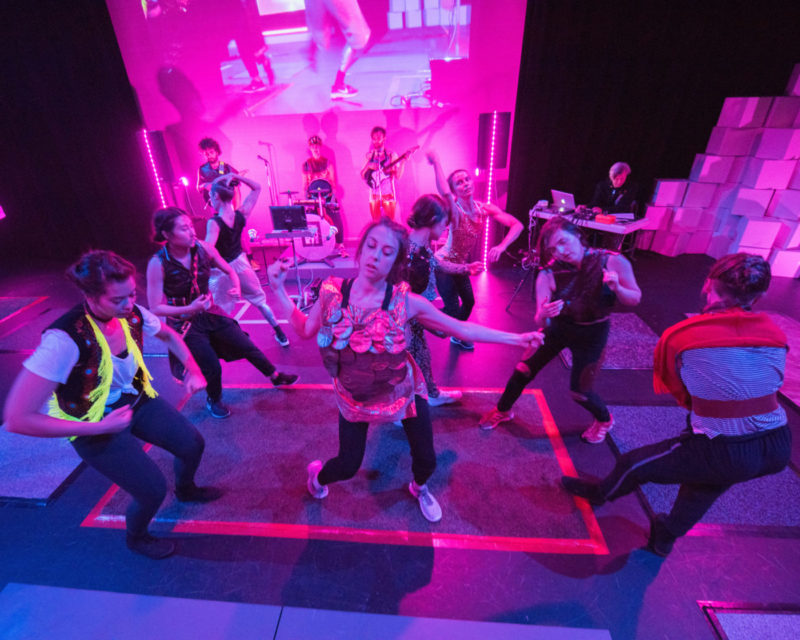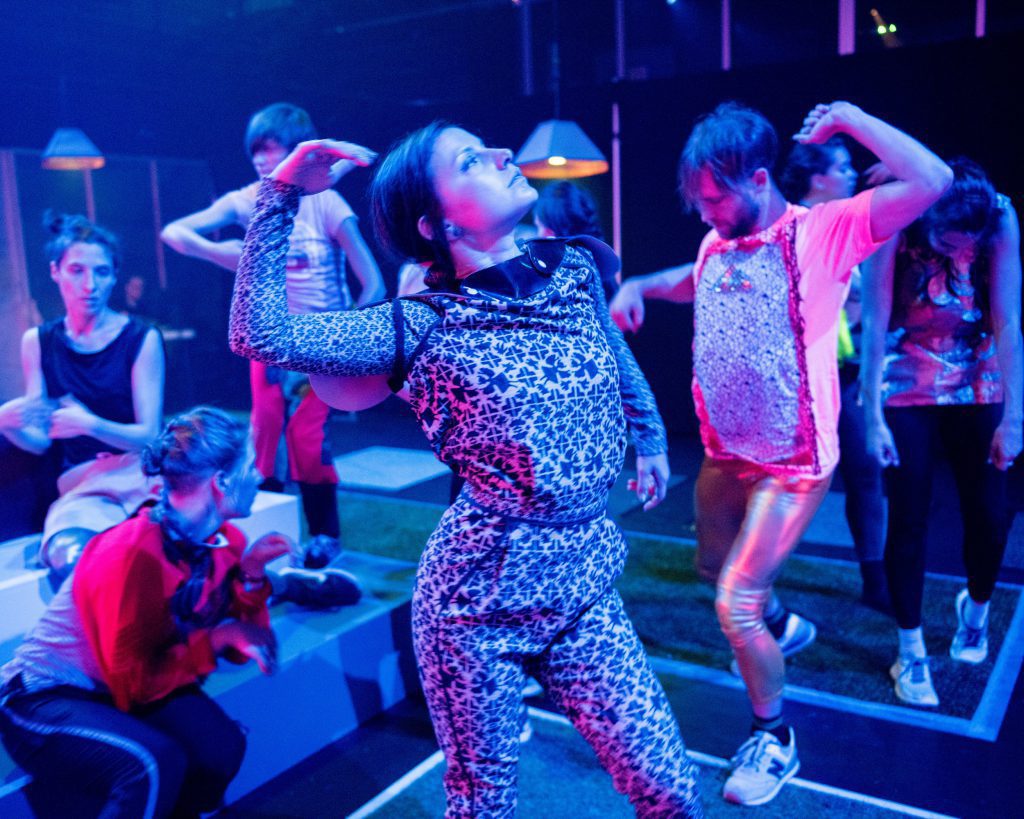Embodying Technology: Plastic Orchid Factory’s DIGITAL FOLK
16 November 2016
By Ella Adkins
DIGITAL FOLK, a three year project created by the artist collective Plastic Orchid Factory, was a costume party, video game and dance extravaganza, an intersection of technology and the physicality of dance, and exemplified how communities gather to play music, dance and tell stories.
Upon arriving at the Fei & Milton Wong Experimental Theatre at SFU Woodward’s in Vancouver’s downtown, I was invited down a small black hallway with several racks of sparkling metallic costumes, all created by visual artist Natalie Purchwitz. “Put one on!” chirped a woman casually sporting a peach vest-cape hybrid complete with horns. Donning my pink metallic tunic, I entered the theatre to find everyone wearing similarly eccentric outfits, all highlighted by the enveloping neon pink haze of the lights above. The layout of the theatre was unified by a tiered rectangular pyramid, upon which some performers were sitting. Ariana Grande’s vocals permeated the space, while on the far side of the room, a group of people were awkwardly “dancing” in front of a small screen, and with my limited video game knowledge to rely on, I came to realize it was PlayStation’s interactive game, “Just Dance”. To my right, a group of people were stumbling through a round of Rock Band. Small square patches of green turf were arranged on the floor and I felt like I was at a soiree of the future. This installation was not so much an object d’art, as it was a gathering space. As “the audience”, we were thrown into this abstract, unrecognizable environment, mixed in with the performance artists, creating a sensation of anticipation and anxiety, since we were fully dissociated from our everyday surroundings. Equalized through our shiny attire, it felt as if there was no other choice but to turn to fellow audience members, sharing nervous smiles and excited giggles. Human interaction and relationships seemed to be the only thing that felt familiar within this unknown and unpredictable space.
The neon lights dimmed and I assumed a seat on the rectangular pyramid. Four screens against each wall projected the animated introduction to the game “The Legend of Zelda”. This narrative gave the audience a hint towards their potential journey through the space, yet it remained ambiguous what would be expected of us, opening a point of entry into the technological framework that the performance rested on. This performance allowed for many perspectives of viewing to be possible, since wherever you had chosen to locate yourself in the room, it shaped your own individual viewing of the piece. The four screens projected the show as it was happening from various video cameras around the stage, creating a multi-dimensional experience, like that of layered realities. This had a disorienting effect, and readily posed the question, where should I look? I found myself caught between looking at the physical performers and their projections. Although one could argue there was no difference between the two, there was a complex nature to viewing the live performance as it happened on a screen. The boundary between what was happening in front of me in the world of the real and what was being projected in the realm of the technological began to blur, as if the corporeal was being ingested, and we, as the spectators, willingly and somewhat subconsciously, followed. The filming of the piece while it was happening cleverly addressed how the video camera can transform, manipulate and instruct how we see what is happening around us, whether it be focusing on certain areas of a space or filming from an obscure angle. These projections seemed to transform an event happening in reality and abstracted it into a lucid, infinite space.

The performers heavily guided this piece as they moved through and around the audience. Sometimes there would be music the dancers would move to with expressive, interpretative movements, reacting to one another, and wavering between moving as one or as individuals. At one point, all the artists pulled out their phones to view a video of folk dancing, and responded to it with mimetic, responsive movement. The video all the performers were watching on their phones was projected onto the screens. The technology of viewing connected us all, however, each artist translated the technological information differently, that was then manifested through their movements. The experimental and improvised choices that each artist made were exciting, as it appeared unexpected and organic, potentially not choreographed, but improvised. After speaking to a performer post-performance, she explained, “Basically we had sections where we knew what tasks needed to be completed and we had a group of people that could participate based on their choices in the previous section. So we kind of stitched together transitions but there was a big element of improvisation, it was different show to show. The audience was a huge influence to the amount of care and trust we gave each performance”. The collaboration of individuals aiming to achieve certain tasks adds yet another meaningful dimension to this piece; while DIGITAL FOLK explores the abstractions and disassociations of technological instruments and programs, there is a counter exploration of an extremely real, visceral, corporeal connection between humans, and the power of the community.
Even though the piece did not demand a narrative, we seemed to be cruelly teased with one. There was a section of dance that was driven by speech, repeated poems or monologues, by a group of dancers that moved together in a clump, each speaking parts of their individual speeches in a language of their choice. It was clear that these were personal monologues and the meaning of some were to remain hidden, each tied closely to the movement they were accompanied with. However, in a space as transcendental as this one, where everything existed on a different plane of time and space, anything familiar, such as an anecdote like the monologues, was clung onto by the audience. This yearning desire for story and structure, explanation and narrative, are also what made the performance so captivating: the work played on the audience’s desire for structure, and denied it.
DIGITAL FOLK was playful, colourful and energetic, and addressed the anxiety of this new, constantly changing technological space that exists within the contemporary everyday experience. DIGITAL FOLK was able to create a communal space where the movement of bodies in dialogue with the various technologies was inviting and organic, but also isolating, which subtly instilled the spectators with a sense of anxiety associated with the digital realm. Technology of the contemporary world has allowed us to experience the outside world through our machines without any human contact, which complicate our real life personal relationships. DIGITAL FOLK encourages this human connection to one’s own body as well as to others using technology as a guide. The rapid connectivity and the impulsive sharing of information act on dual platforms, one of connection and sharing of ideas, and the other as a human disconnection through the abstraction of technology, and a loss of physical relationship. DIGITAL FOLK could be experienced through a more superficial viewpoint as pure fun and whimsies. But through the work’s use of layered perspective and technological elements, such as video games and smartphones, we are warned of the power of technology, of the internet, this unforeseeable force that controls all, and seems to consume us when we least expect it.
Feature and inset images by Chris Randle for Plastic Orchid Factory.



